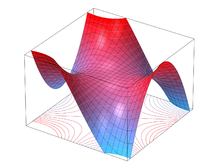Monkey saddle
The monkey saddle is a spatial surface that is described in a three-dimensional Cartesian coordinate system by the graph of the function .
Characteristic of the function
The area is characterized by three elevations and three depressions that meet at the origin . The plane is axially symmetrical to the z-axis, namely with a rotation of 2 π / 3 rad or 120 ° with any orientation .
Origin of name
The name "monkey saddle" is derived from the similarity of the graph to the shape of a riding saddle . However, since there are three indentations for the two legs of the rider instead of two, the function “monkey saddle” was named; it found a further reduction in the tail of the monkeys .
Web links
- Monkey saddle. In: Mathematik-Online-Lexikon. University of Stuttgart / University of Ulm , January 25, 2006, accessed on January 5, 2011 .
- Model: Affensattel (two copies). In: Mathematical Models - Collection of the Technical University of Dresden . Retrieved January 5, 2011 .
Individual evidence
- ↑ Wolfgang Kühnel : Differential Geometry. Curves - surfaces - manifolds. 4th revised edition. Vieweg, Wiesbaden 2008, ISBN 978-3-8348-0411-2 , p. 51.

